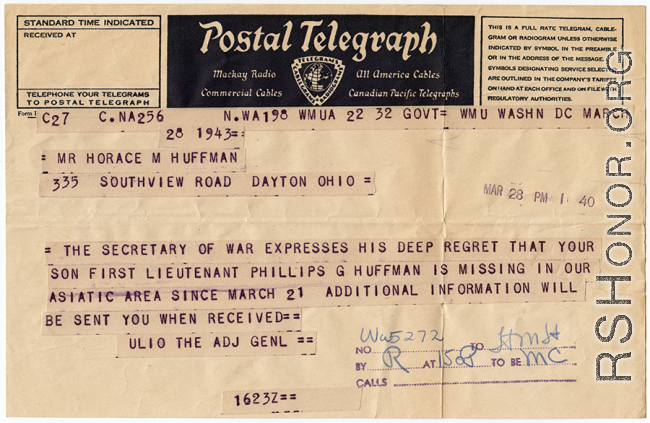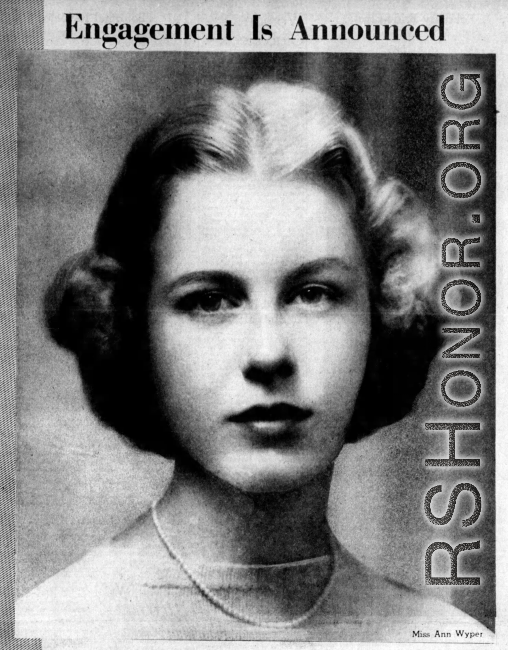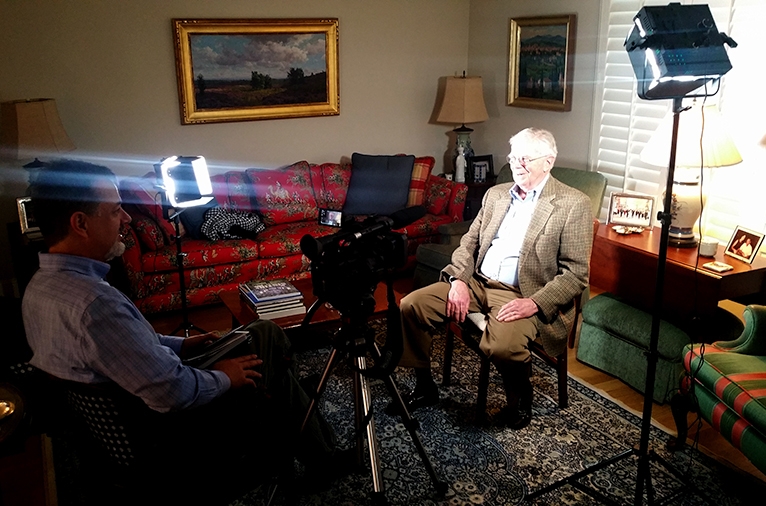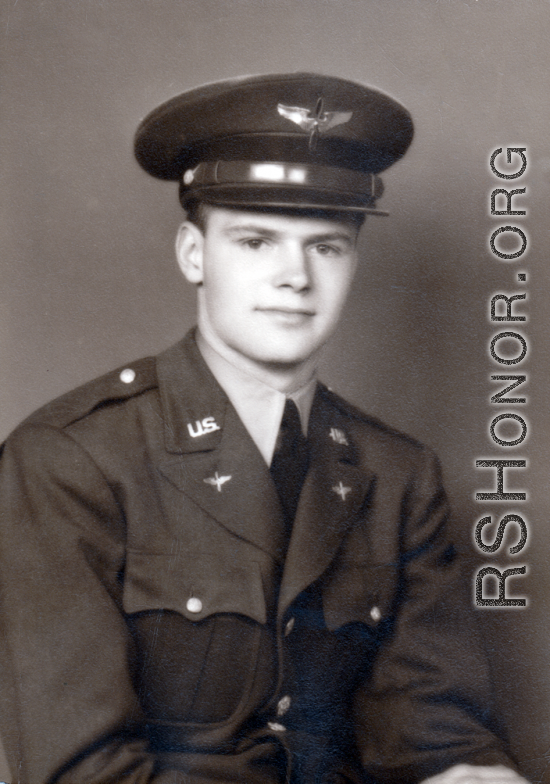1st Lt. Phillips Gardner Huffman was lost on a flight on March 21, 1943, over the Hump on B-24 "The Pregnant Swan," #42-40069, while enroute from Pandaveswar, India to Kunming, China.
During the flight there was no radio "advice" sent out from the crew indicating any trouble. The craft simply disappeared on this, their first, flight over the treacherous altitudes of the Hump.
Phillips was born May 26, 1918, in Dayton, Ohio, the fourth child (of five) of Horace McKee Huffman, Sr., and Mary Reynolds Huffman. He attended school in Oakwood, a town on the environs of Dayton. Phillips Huffman graduated in June, 1940, from Dartmouth College. He was a member of Theta Delta Chi fraternity.
After graduation, in 1940 he joined the family business, Huffman Manufacturing Company (later Huffy Corporation) in Dayton, Ohio, in sales, supervised by his older brother "Huffy," having previously spent two summers working at the family plant gaining insight into the making of the bicycles, as well as office routine.
Phillips registered for the draft on October 16, 1940.
On January 26, 1941, the engagement of Phillips Huffman and Miss Ann Wyper (also of Dartmouth College) was announced.
On April 19, 1941, Phillips enlisted at Hartford, Connecticut in the Army Engineer Corps , and was assigned to an engineering unit at Camp Edwards, Falmouth, Massachusetts.
In late May, 1941, enlisted-man Huffman, on a break from Camp Edwards, was guest for the weekend at the home of the parents of his fiancée, Ann Wyper. Ann's brother James was also stationed at Camp Edwards, and visited the home that same weekend.
In July, 1941, "Corporal" Huffman, was guest for the weekend at the home, where one of his sisters was also houseguest.
Corporal Huffman became an Aviation Cadet in the U.S. Army Air Forces, and entered pilot training, on December 20, 1941.
On March 2, 1942, the wedding of "Aviation Cadet" Phillips Huffman and Miss Ann Wyper was announced for Saturday, March 21 at Decatur, Alabama. They were married at St. John's Episcopal church in Decatur. A friend loaned his car to Phil and Ann for a brief wedding trip.
In May 1942 the newlywed couple were guests in his parents home for several days, and attended a friend's wedding, after which he was transferred to a new post.
Phillips attended flying schools at Decatur, Alabama and Greenville, Mississippi (in the fourth cadet class; spring 1942), then entered the newly established Columbus Army Flying school (with his wife Ann residing with him; May 1942), near Columbus, Mississippi. He graduated in July of 1942, with the commission of second lieutenant in the Army Air Forces. By October 1942, he was stationed in Tucson, Arizona, with Ann residing with him. His parents visited them for a few weeks.
In early 1943, he was put in command of a B-24 crew and bomber, nicknamed "Pregnant Swan," serial #42-40069, and assigned to the 425th Bomb Squadron, 308th Bombardment Group.
Lt. Huffman spent January 6 - 10, 1943, with his parents, then on February 15, 1943, the planes of his squadron set forth from Morrison Field, West Palm Beach, Florida, over the sea towards Puerto Rico. Not at this point even knowing their final destination or mission--not even the 308th’s commander, Colonel Eugene H. Beebe knew.
After the group arrived in Puerto Rico, Col. Beebe met with General Arnold, who was returning from China following a review of facilities and capabilities there. Arnold finally informed Beebe that the Group was heading to the CBI. Gen. Arnold spoke to the air crews about their destination and purpose, an event of great excitement to a young Lt. Huffman, in some thrill and awe of being in the presence of such elevated personages, and of being treated as important by such. In a letters of February 20th and 27th, Lt. Huffman wrote home with excitement that, despite not being able to share any details, he had learned from Arnold's speech about the "big and wonderful things ahead of" the 308th, and that "we are out on a special mission for the General." This special mention also included a grand experiment: Could a bomber unit sustain itself so far from supply lines without transport aircraft in support? The B-24 bombers would need to make repeated trips over the Hump to for a large portion of their own fuel and munitions, with many Hump trips needed for a single combat mission.
From Puerto Rico, the flying crews of the Group proceeded forward to Grand Cayman, Brazil, Ascension Island, Accra, Sudan, Aden, Karachi, Agra (where he saw the Taj Mahal), Calcutta, and finally to Chabua in Assam State, India. They would arrive at Chabua, in early March, 1943.
However, Lt. Huffman had been delayed with an illness at a stop over in West Africa, and his crew had flown on without him. On February 25 he wrote that he had had a cough that had kept him up, so had gone to the infirmary for cough syrup. But once in the hands of the medical types, his fortunes had changed when they had declared that he had measles. He was flat on his back in the hospital--the doctor said hospitalization would be for ten days! Maj. Fensler had taken over his crew, as his squadron, the 425th--the lead squadron--continued east towards India, until Lt. Huffman would catch up. But lying on his back and "reading detective stories" did not suit him, and two days later Lt. Huffman wrote that he was setting out to catch up with his crew, his measles symptoms apparently already abated. He would catch a ride from a plane of the last squadron, still parked at the nearby airfield.
His wanted to be with his men, and was probably also worried a bit about losing some informal leadership authority with his crew to the more senior Major Fensler, who was in the pilot seat that rightfully belonged to Huffman. Huffman's urgency was obvious, "I should catch my boys before we leave this continent."
He took around five days to catch up to his squadron, first riding with the last squadron until it laid over at a city on the Upper Nile, then jumping to another squadron that was ready to go forward, and then hopping again to a single airplane that was also trying to catch up to its squadron. All so as "to be back with my boys" as soon as possible.
Phillips wrote to his family with great enthusiasm of the curious people and places he saw as he traveled, making observations as he went, enjoying the beautiful scenery, and reassuring his wife and family that he was well and in good spirits. His letters convey a sense of awe, adventure, and good fortune to be traveling and seeing the world. On March 4, already in India, he wrote to his parents:
"What a small world it really is. Imagine your son half-way around the world, having crossed the equator twice, the dark Continent of Africa, the Red Sea (which looked to me as blue as Lake Michigan), and the Arabian sea? I really hold quite a number of family records now, don't I?"
There was a delay of few weeks in India before the Group would fly over the Hump into China, and Phillips chafed at the delay, eager to get to his mission. He complained that "The Colonel has been off surveying the world and we've sat around waiting for him."
In fact, Col. Beebe was occupied in preparing for the Group to transit to China. Only while the Group was enroute to India had it been decided to place the group instead in China proper, in order to put them within range of Japanese airfields in East China and also to be in position to pound strategic targets in the Indo-China region. Upon arrival in India, Beebe had set to work, visiting bases in the area, gathering charts for the route of the flight from Chabua, which was to be the western terminus of the 308th's operations, to China, and indeed, even making a round-trip flight over the Hump to China to check out conditions there with the four squadron leaders (including Major Fensler, C. O. of the 425th). This critical work all took time.
But this delay gave an impatient Lt. Huffman opportunity to think. Clearly stimulated by what he had learned in Puerto Rico from General Arnold's inspiring talk, on March 16, 1943, he wrote from India some of his contemplations about his role in his small corner of the war, and he sought out meaning for his participation:
"We are to be part of the new 14th Air Force in China under General Chennault, and I'm tickled pink with the prospect. In addition to fighting under probably the greatest technical and tactical airman this war has produced, we are also fighting for the Chinese, and if ever a nation deserved a little help, they do. The French and the British (and ourselves, to a certain extent) have it coming to us because we sat by and let Germany develop when we could have done something about it, but the Chinese never had a chance. Too broken up to have a unified command and too poor to have any material to fight with, they were an easy mark for the Japanese. I hope and think we'll change that situation a great deal."
On March 21, 1943, just five days later, the group set out on the fateful trip over the Hump. And sure enough, as Lt. Huffman had possibly feared, Major Fensler was in command for this flight, although possibly not so much because Major Fensler had established a leadership role with Lt. Huffman's crew, but more because Major Fensler wanted to experience the difficulties his pilots would encounter while flying the 'self-supporting' supply replenishment missions which would sustain the 308th Bomb Group throughout its assignment in China.
After Lt. Huffman disappeared, his wife Ann moved back in with her parents in West Hartford, Connecticut. In the many months that followed without news of the crew, those who loved Phillips Huffman struggled to accept the painful circumstances of not knowing whether he was lost or alive, and they talked among themselves as they tried to cope, and reached out to officials, or other military personnel in China who they knew. Families of some of crew corresponded, and the family of Robert W. Fensler was especially supportive, and the two families shared letters of encouragement, and numerous theories about how the crew might have survived--by landing at a remote airfield, or building a runway on a rice paddy then flying the plane again, or walking out of the jungle with their survival gear in hand, etc. Over the long wait for someone forever missing this can become a painful habit, of never quite being able to put the loved one to rest, and this was case for Phillips' family.
The date of his loss was exactly one year after his wedding, on his first anniversary. He was 24 years old. Later, with no confirmed remains, there was a "finding of death" for him and the crew announced in late June, 1946, and he was "declared dead" by the War Department in late January, 1946. Memorial services were held for him at St. Paul's Episcopal Church in February 1946. His will, which entered probate in May, 1946, specified a trust fund be established for the benefit and caring of his wife. In December 1947, his mother donated two altar candlesticks to him which were dedicated during an elaborate service at St. Paul's Episcopal Church.
1st Lt Phillips G. Huffman is remembered at the Tablets of the Missing at Manila American Cemetery, Philippines.
On the flight all ten crew were lost:
Maj Robert W. Fensler, Command Pilot/Acting Pilot (or "passenger" in some accounts) (CA)
1st Lt Phillips G. Huffman, Pilot (OH)
1st Lt Jerrold E. Owens, Co-pilot (OK)
1st Lt Frederick W. Ossenfort, Navigator (NY)
1st Lt Harvey M. Nix, Jr, Bombardier (AL)
T/Sgt Norman H. Price, Radio Operator (LA)
S/Sgt Louis E. Verhaegen, Asst Radio Operator (NJ)
T/Sgt Erle H. Thayer, Flight Engineer (KS)
S/Sgt Aubrey E. Stevenson, Asst Flight Engineer (OK)
S/Sgt. Sandow E. Rivardo, Gunner (NY)
On September 20, 2008, the site of the crash was located near the town of Itanagar, in Arunachal Pradesh, India.
(Text above compiled/written by Patrick Lucas, and includes partial text and information from sources graciously provided by Steve Huffman, nephew of Phillips, and invaluable research and insights from Tony Stroman, as well as excerpts from Chennault's Forgotten Warriors, The Saga of the 308th Bomb Group in China by Carroll V. Glines, as well as from other sources.)




